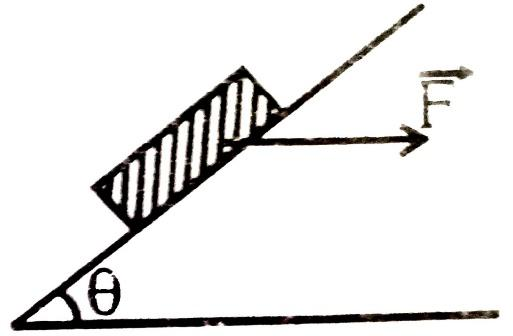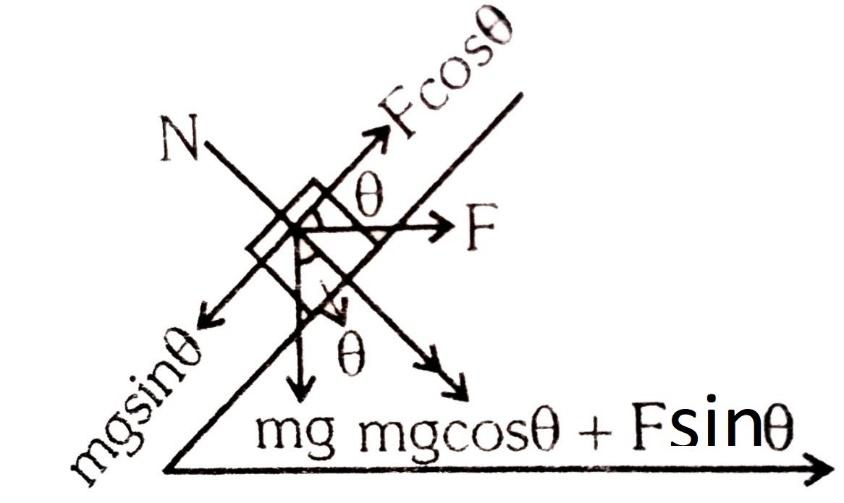
The figure shows a horizontal force $\vec F$ acting on the block of mass $M$ on an inclined plane (angle $\theta $ ). What is the normal reaction $N$ on the block?

A) $mg\,\sin \theta + F\,\cos \theta $
B) $mg\,\sin \theta - F\,\cos \theta $
C) $mg\,\cos \theta - F\sin \theta $
D) $mg\,\cos \theta + F\,\sin \theta $
Answer
142.8k+ views
Hint: Construct the diagram of the horizontal force given and also the force due to the weight of the block taken. Split these two forces into horizontal components and the vertical component to obtain the resultant force and the normal force to it.
Complete step by step solution:
It is given that the
Horizontal force acting on the block is $\vec F$
The mass of the block is $M$
The mass is at an angle of $\theta $ on the inclined plane
Since $\vec F$ is the horizontal force that acts on the block, it pushes the block to move upward on the slanting inclined plane. There will be the force which acts against it and downwards. It is formed by the combination of the weight of the block and the gravitational force of the block towards the earth. According to Newton's second law of motion, force is the product of the mass and the acceleration.
${F_w} = mg$
This force pulls the block towards down against the horizontal external force. Let us construct the diagram of the case given.

From the constructed diagram, the force $mg$divided into $mg\,\sin \theta $ and $mg\,\cos \theta $. And the horizontal force divided into $F\sin \theta $ and $F\,\cos \theta $ . If we take the normal, the answer is $mg\,\cos \theta + F\,\sin \theta $.
Thus the option (D) is correct.
Note: It is to be noted that when the vector of the force is divided into the horizontal and the vertical component, the sine of the force magnitude is taken as the vertical component of force and the cosine is taken as the horizontal component.
Complete step by step solution:
It is given that the
Horizontal force acting on the block is $\vec F$
The mass of the block is $M$
The mass is at an angle of $\theta $ on the inclined plane
Since $\vec F$ is the horizontal force that acts on the block, it pushes the block to move upward on the slanting inclined plane. There will be the force which acts against it and downwards. It is formed by the combination of the weight of the block and the gravitational force of the block towards the earth. According to Newton's second law of motion, force is the product of the mass and the acceleration.
${F_w} = mg$
This force pulls the block towards down against the horizontal external force. Let us construct the diagram of the case given.

From the constructed diagram, the force $mg$divided into $mg\,\sin \theta $ and $mg\,\cos \theta $. And the horizontal force divided into $F\sin \theta $ and $F\,\cos \theta $ . If we take the normal, the answer is $mg\,\cos \theta + F\,\sin \theta $.
Thus the option (D) is correct.
Note: It is to be noted that when the vector of the force is divided into the horizontal and the vertical component, the sine of the force magnitude is taken as the vertical component of force and the cosine is taken as the horizontal component.
Recently Updated Pages
How to find Oxidation Number - Important Concepts for JEE

How Electromagnetic Waves are Formed - Important Concepts for JEE

Electrical Resistance - Important Concepts and Tips for JEE

Average Atomic Mass - Important Concepts and Tips for JEE

Chemical Equation - Important Concepts and Tips for JEE

Concept of CP and CV of Gas - Important Concepts and Tips for JEE

Trending doubts
JEE Main 2025 Session 2: Application Form (Out), Exam Dates (Released), Eligibility, & More

JEE Main Exam Marking Scheme: Detailed Breakdown of Marks and Negative Marking

JEE Main 2025: Derivation of Equation of Trajectory in Physics

Electric Field Due to Uniformly Charged Ring for JEE Main 2025 - Formula and Derivation

Degree of Dissociation and Its Formula With Solved Example for JEE

Physics Average Value and RMS Value JEE Main 2025

Other Pages
Units and Measurements Class 11 Notes: CBSE Physics Chapter 1

JEE Advanced Marks vs Ranks 2025: Understanding Category-wise Qualifying Marks and Previous Year Cut-offs

NCERT Solutions for Class 11 Physics Chapter 1 Units and Measurements

JEE Advanced 2025: Dates, Registration, Syllabus, Eligibility Criteria and More

Motion in a Straight Line Class 11 Notes: CBSE Physics Chapter 2

JEE Advanced Weightage 2025 Chapter-Wise for Physics, Maths and Chemistry




